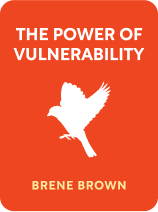

This article is an excerpt from the Shortform book guide to "The Power Of Vulnerability" by Brené Brown. Shortform has the world's best summaries and analyses of books you should be reading.
Like this article? Sign up for a free trial here .
Do you want to know how to be your authentic self? Are you being held back by other people’s expectations, your own perfectionism, or your distrust of your intuition?
Brené Brown’s first five practices for wholehearted living focus on how to be your authentic self. She discusses the importance of saying “no,” the dangers of perfectionism, the fear that some people feel when things are going too well, and more.
Continue reading for Brené Brown’s first five practices for wholehearted living.
Wholehearted Thinking (Practices #1-5)
Wholehearted living requires active engagement and constant reflection. There are 10 practices for living wholeheartedly. This article will cover practices 1-5 because they teach you how to be your authentic self.
The first five practices promote healthy thinking and internal reflection. They are mostly internal practices that will help you let go of the mental roadblocks you may face on your way to wholehearted living.
Practice #1: Live Authentically by Letting Go of Other People’s Expectations
Authenticity is the process of accepting ourselves for who we really are and abandoning the idea of who we think we’re supposed to be. By placing value on your own needs and identity, authenticity helps develop your sense of self-worth. There are three requirements for authentic living:
- Embrace imperfection
- Create boundaries
- Be willing to be vulnerable
This can be a challenging process as human beings are hard-wired to want to fit in with others, often by adhering to external expectations. For example, if you want to make a good impression on a new co-worker, you may agree to every favor that they ask of you, even if it leads to unnecessary stress.
To begin living authentically, consider the following tips:
Be Willing to Say “No”
If someone asks you to do something that you don’t want to do or don’t feel you can do without overwhelming yourself, say “no.” You may frustrate some people when you begin to do this, but agreeing to do something you don’t want to do builds the foundation for resentment. For example, if your friend asks you for help filing their paperwork on a Friday afternoon when you’ve already worked a full 40-hour workweek, saying “yes” may lead to unnecessary frustration.
To prepare yourself, practice saying “no” in the mirror, and bring notes with you when you’re turning someone down. These habits allow you to become more comfortable in the situation and allow you to keep your emotions from clouding your judgment.
Note: This doesn’t mean you have to say “no” every time someone asks you to do something for them. You can help people when they reach out but have a clear sense of your level of stress or exhaustion and don’t overextend yourself.
Be Willing to Say “Yes”
Conversely, if you find a project or venture that you’re genuinely excited about, say “yes.” Often, the prospect of imperfection or ineptitude may keep you from diving in. However, if you allow fear to dictate your behavior, you’ll never be willing to try new things or engage with projects that excite you.
For example, if you’ve always been interested in taking a painting class, take a painting class. Though you may be afraid that your lack of artistic experience may lead to shame, you’ll never know what benefits the class will provide if you never take the leap of faith.
Develop a Mantra
Create a simple mantra based on an authenticity goal. Repeat this phrase to yourself before entering high-stress situations to remind you to practice authenticity. For example, if your goal is to accept that your needs are important enough to say “no” to things, you could say to yourself, “My needs outweigh others’ expectations.”
Practice #2: Use Self-Compassion to Combat Perfectionism
As you learned earlier, perfectionism is a key cause of shame. It’s also extremely contagious and can be passed along to your children. For example, if you obsess over turning in perfect projects, you may demand that same level of perfection from your child in their schoolwork, causing them to feel shame if they create anything that is less than perfect.
Self-compassion is the antidote to perfectionism because it allows you to learn from your mistakes without connecting them to your self-worth. There are three aspects of self-compassion:
- Self-kindness, or the willingness to be kind to yourself when you make a mistake. For example, if you burn a plate of cookies that you were meaning to use for the PTA meeting, forgive yourself for the error instead of falling into shame.
- Critical awareness, or the understanding that you are not the only person experiencing your struggle. For example, if you struggle with addiction, embrace the knowledge that others struggle with the same thing. This will prevent you from associating your addiction with your self-worth.
- Mindfulness, or the practices that help you work through what you’re feeling and provide comfort. These practices could include meditation, self-care, or activities. For example, if you’ve had a hard day at work, a warm bath can help you calm down and give you a relaxed environment to feel your emotions without spiraling into shame.
Note: With mindfulness practices, be careful to avoid crossing the line from comforting behavior into numbing behavior. For example, eating a cookie to have a bit of joy at the end of a long day is different from eating an entire box of cookies in an attempt to suppress your feelings.
Practice #3: Generate Resilience Through Spirituality and Congruent Living
Resilience is your ability to recover from stress or trauma:
- A high level of resilience means that you can recover quickly from trauma and move forward. For example, if a report that you’d worked on for hours got deleted from your computer, you’d be able to jump right back in after taking a second to breathe or problem-solve.
- A low level of resilience means that you recover slowly and shut down in moments of extreme stress. For example, if a report that you’d worked on for hours got deleted from your computer, you’d likely spiral into shame and shut down, preventing you from getting back to work.
To develop high levels of resilience, practice the following:
Congruent Living
Take the time to relax and replenish your energy by practicing congruent living, or living life based on how you’re naturally built. You’re more “hard-wired” than you think, meaning that certain traits such as introversion or extroversion are outside of your control.
Know what your body needs to recover and find the time to engage with those practices. For example, if you know you need to take 45 minutes of alone time before bed to wind down, schedule that time into your day.
If you try to live your life in a way that runs counter to the way your brain works, you’ll exhaust yourself quickly and won’t have the energy for resilience. Often, this leads to unhealthy coping mechanisms such as numbing or addictive behaviors.
For example, if you’re an introvert who’s always around people, you’ll never have the alone time to replenish your energy. Therefore, when a crisis occurs, you won’t have the energy to bounce back. This could lead to shame, which could lead to the development of a numbing behavior.
Spirituality
Spirituality is the belief that all people are connected by something greater than themselves. This allows you to lift some of the burdens of life from your own shoulders, and give them to a higher power. This also creates purpose and perspective, generating empathy and drive in the process.
Note: Spirituality isn’t inherently linked to organized religion. Though some people may find their spirituality through religions such as Islam, Christianity, or Judaism, spirituality can also be a personal perspective.
Healthy Venting
Venting is important. It lets you feel your emotions and allows you to express the severity of your current situation. When venting, you don’t have to lie about your feelings, even if they’re unpopular or uncomfortable. However, be sure to maintain some perspective when venting. Don’t compare your feelings or situation to others because you don’t know what other people are going through.
For example, if your house loses power because of a tornado, venting about your frustration can be healthy. However, if you start claiming that you have it worse than anyone else, you’re invalidating and ostracizing the people around you, especially those who may have lost homes or family members.
Practice #4: Avoid Foreboding Joy by Practicing Gratitude
Foreboding joy is the feeling of apprehension that develops when things are going well. For example, if you have kids, and you go out with your significant other for the night, foreboding joy would be spending the entire date night worrying about your children with the babysitter instead of enjoying your time with your partner.
This apprehension is a defense mechanism based on the belief that preparing for the worst will help with one of two stressors:
- Tragedy. Some believe that expecting tragedy will help build their resilience if the worst happens. For example, if you’re constantly worrying about the death of a family member, you may think that their eventual passing will be less devastating.
- Disappointment. Some believe that restricting their excitement will help build their resilience if they don’t succeed. For example, if you’re building a new company, you may restrict your expectations out of fear of “getting your hopes up.”
However, foreboding joy doesn’t work in practice. No amount of preparation can lessen the impact of tragedy or disappointment, meaning that apprehension squanders positive emotions without providing any benefit. Don’t sacrifice your joy in the moment to fear for an unknown eventuality you have no control over.
Gratitude: The Antidote to Foreboding
How do the most joyful people avoid succumbing to fear? They practice gratitude. Gratitude doesn’t happen on its own. It requires attention and engagement. A few methods to practice gratitude include:
- Keeping a gratitude journal. Every day, sit down for a few minutes and write down a few things that you’re grateful for. These lists help you find the joy in your life, even in moments of extreme crisis.
- Talking about your gratitude with others. Sharing with others helps you solidify the things that bring you joy and creates a positive and supportive environment for others.
- Training your mind to habitually respond with gratitude instead of fear. Whenever you feel a sense of foreboding, force yourself to think about the things you’re grateful for in that moment. With enough practice, your body can start responding with gratitude automatically.
- Finding joy in the “mundane.” Cherish the small moments you have with friends and loved ones. One of the most common regrets people experience at the end of their lives is not spending enough time enjoying the company of those they care about.
Graphic Imagery and Foreboding Joy
The human brain isn’t hardwired to process fictional violence. Your brain is built to believe whatever it sees, even if you’re watching a movie or TV show. This is why genres such as horror can create visceral responses. This physiological reaction constantly reminds you of how quickly and painfully life can be taken away, making foreboding joy a more common experience.
Practice #5: Listen to Your Intuition by Embracing Uncertainty
Intuition is personal insight commonly described as a “gut instinct.” This feeling develops through experience and helps shape your perspective on the world. Intuition is directly tied to authenticity as it represents your subconscious response to the world around you.
In times of uncertainty or confusion, many ignore their intuition and make decisions based on more “comfortable” methods:
- Polling: Asking others to provide answers to problems to ease uncertainty.
- “Bull in the China Shop”: Making a decision without thinking because it’s “easier” than the discomfort of uncertainty.
In both of the above methods, personal perspective is ignored, often leading to poor decision-making. For example, if you’re unsure about accepting a new job, you may ask your friends to guide your decision. If your “gut” is telling you to take the job, but your friends talk you out of it, you may be missing out on an opportunity that would bring you fulfillment as you allowed others to make your decision for you.
To start listening to your intuition, you must first accept that certainty isn’t real. The world is constantly changing, and no one can predict the future. Learning to sit with uncertainty and allowing your instincts to guide your decision-making process often leads to clarity and fulfillment.
As you begin to embrace uncertainty, allow yourself to sit in silence. You don’t need to fill every moment, and scheduling time to do nothing but sit with yourself can be helpful as you work to get in touch with your personal intuition.
Uncertainty and Faith
Faith is an important aspect of embracing uncertainty. It gives you the courage to walk into the unknown while believing in something greater than yourself. Similar to spirituality, faith doesn’t have to be associated with religion. While it may be the source of faith for others, you can have faith without having to subscribe to organized religion.
Contrary to popular academic perspectives, faith and reason aren’t automatically at odds with one another. This debate comes from shame associated with the need for certainty. Many researchers call faith “unreasonable” because it implies that there are things that we may never understand, a perspective that they associate with ignorance. However, uncertainty is an integral part of the human experience. The only “reasonable” way to live is to accept that we’ll never know everything.

———End of Preview———
Like what you just read? Read the rest of the world's best book summary and analysis of Brené Brown's "The Power Of Vulnerability" at Shortform .
Here's what you'll find in our full The Power Of Vulnerability summary :
- The 10 practices that you can use to embrace vulnerability and start living a wholehearted life
- Why thinking that you're never "enough" is dangerous
- The most common sources of shame and how to overcome them






